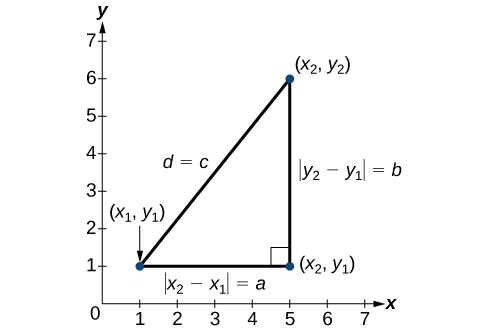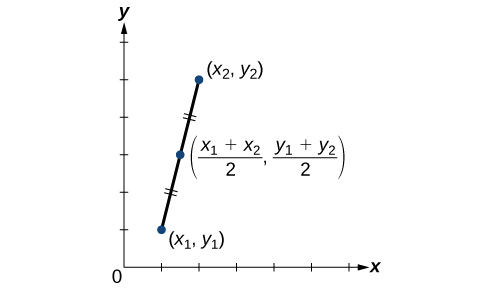Learning Objectives
- Use the distance formula to find the distance between two points in the plane
- Use the midpoint formula to find the midpoint between two points
Derived from the Pythagorean Theorem, the distance formula is used to find the distance between two points in the plane. The Pythagorean Theorem, [latex]{a}^{2}+{b}^{2}={c}^{2}[/latex], is based on a right triangle where a and b are the lengths of the legs adjacent to the right angle, and c is the length of the hypotenuse.

The relationship of sides [latex]|{x}_{2}-{x}_{1}|[/latex] and [latex]|{y}_{2}-{y}_{1}|[/latex] to side d is the same as that of sides a and b to side c. We use the absolute value symbol to indicate that the length is a positive number because the absolute value of any number is positive. (For example, [latex]|-3|=3[/latex]. ) The symbols [latex]|{x}_{2}-{x}_{1}|[/latex] and [latex]|{y}_{2}-{y}_{1}|[/latex] indicate that the lengths of the sides of the triangle are positive. To find the length c, take the square root of both sides of the Pythagorean Theorem.
It follows that the distance formula is given as
We do not have to use the absolute value symbols in this definition because any number squared is positive.
A General Note: The Distance Formula
Given endpoints [latex]\left({x}_{1},{y}_{1}\right)[/latex] and [latex]\left({x}_{2},{y}_{2}\right)[/latex], the distance between two points is given by
Example: Finding the Distance between Two Points
Find the distance between the points [latex]\left(-3,-1\right)[/latex] and [latex]\left(2,3\right)[/latex].
Try It
Find the distance between two points: [latex]\left(1,4\right)[/latex] and [latex]\left(11,9\right)[/latex].
Try it now
In the graph below, you can move the points around the coordinate plane by clicking on them and dragging them. Try it out to see how the distance between them changes.
Choose two points and answer the following questions:
- Calculate the lengths of the sides of the triangle made by the two points you chose and the corner point connected to them by green dotted lines.
- What parts of the distance formula are these lengths?
https://www.desmos.com/calculator/nrtjcgmy69
In the following video, we present more worked examples of how to use the distance formula to find the distance between two points in the coordinate plane.
Example: Finding the Distance between Two Locations
Tracie set out from Elmhurst, IL, to go to Franklin Park. On the way, she made a few stops to do errands. Each stop is indicated by a red dot. Find the total distance that Tracie traveled. Compare this with the distance between her starting and final positions.

Use the Midpoint Formula
When the endpoints of a line segment are known, we can find the point midway between them. This point is known as the midpoint and the formula is known as the midpoint formula. Given the endpoints of a line segment, [latex]\left({x}_{1},{y}_{1}\right)[/latex] and [latex]\left({x}_{2},{y}_{2}\right)[/latex], the midpoint formula states how to find the coordinates of the midpoint [latex]M[/latex].
A graphical view of a midpoint is shown below. Notice that the line segments on either side of the midpoint are congruent.

Example: Finding the Midpoint of the Line Segment
Find the midpoint of the line segment with the endpoints [latex]\left(7,-2\right)[/latex] and [latex]\left(9,5\right)[/latex].
Try It
Find the midpoint of the line segment with endpoints [latex]\left(-2,-1\right)[/latex] and [latex]\left(-8,6\right)[/latex].
Example: Finding the Center of a Circle
The diameter of a circle has endpoints [latex]\left(-1,-4\right)[/latex] and [latex]\left(5,-4\right)[/latex]. Find the center of the circle.
Try It
Try It
In the graph below,there is a circle with a diameter whose endpoints are (0,5), (10,5).
- Find the center of the circle.
- Place a point at the center of the circle.
- Now move the endpoints of the diameter by clicking on them and dragging them. Notice that the size and location of the circle changes.
- Now, graph the center point of a circle of any radius given that the equation for a circle of any radius with any center, [latex](h,k)[/latex] is [latex](x-h)^2+(y-k)^2 = r^2[/latex].
https://www.desmos.com/calculator/j2blmpiid7
Candela Citations
- Revision and Adaptation. Provided by: Lumen Learning. License: CC BY: Attribution
- Midpoint Interactive. Authored by: Lumen Learning. Located at: https://www.desmos.com/calculator/j2blmpiid7. License: CC BY: Attribution
- Distance in the Plane Interactive. Authored by: Lumen Learning. Located at: https://www.desmos.com/calculator/nrtjcgmy69. License: Public Domain: No Known Copyright
- College Algebra. Authored by: Abramson, Jay et al.. Provided by: OpenStax. Located at: http://cnx.org/contents/9b08c294-057f-4201-9f48-5d6ad992740d@5.2. License: CC BY: Attribution. License Terms: Download for free at http://cnx.org/contents/9b08c294-057f-4201-9f48-5d6ad992740d@5.2
- Question ID 19140. Authored by: Amy Lambert. License: CC BY: Attribution. License Terms: IMathAS Community License CC- BY + GPL
- Question ID 2308. Authored by: David Lippman. License: CC BY: Attribution. License Terms: IMathAS Community License CC- BY + GPL
- Question ID 110938. Authored by: Lumen Learning. License: CC BY: Attribution. License Terms: IMathAS Community License CC- BY + GPL
- Example: Determine the Distance Between Two Points. Authored by: James Sousa (Mathispower4u.com). Located at: https://youtu.be/Vj7twkiUgf0. License: CC BY: Attribution
- College Algebra. Authored by: OpenStax College Algebra. Provided by: OpenStax. Located at: http://cnx.org/contents/9b08c294-057f-4201-9f48-5d6ad992740d@3.278:1/Preface. License: CC BY: Attribution
